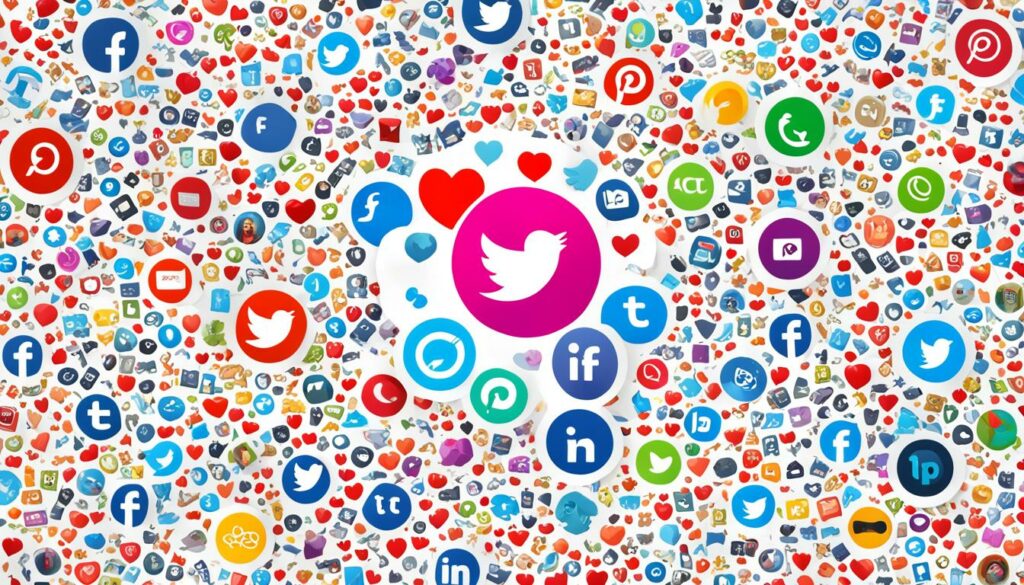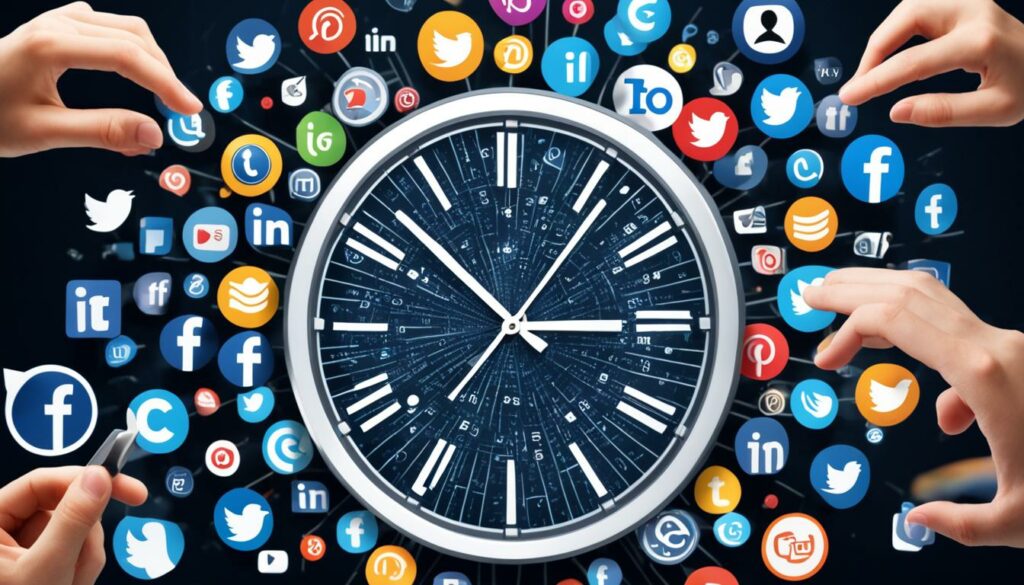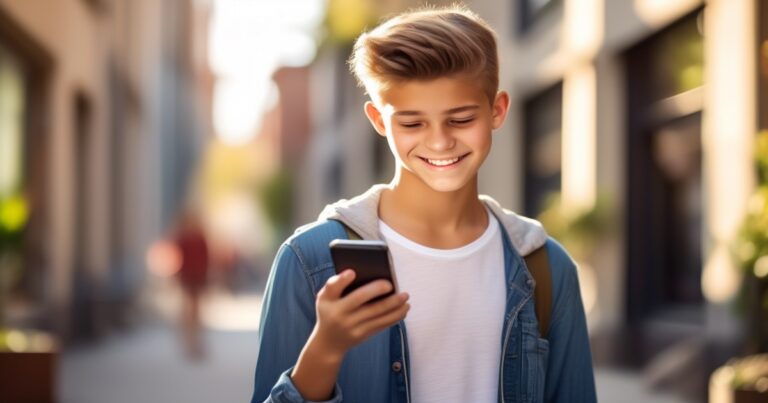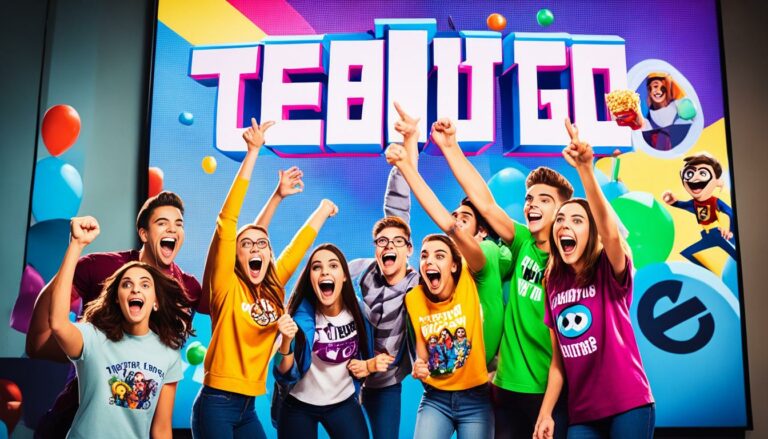Teens’ Social Media Time: Insights & Stats
A study conducted by Pew Research Center has shed light on the social media habits of teenagers in the United States. With the rise of digital technology, it comes as no surprise that social media plays a significant role in the lives of today’s teens. But just how long do they spend on social media platforms? Let’s explore the key findings.
Key Takeaways:
- Teenagers in the United States spend a significant amount of time on social media platforms.
- TikTok has gained popularity among teens, while Facebook’s usage has declined.
- YouTube remains the most commonly used platform among teens, followed by TikTok, Instagram, and Snapchat.
- Social media usage varies by demographic factors such as gender and race/ethnicity.
- A substantial portion of teens use social media on a daily basis and believe they spend the right amount of time on these platforms.
Teens’ Preferred Social Media Platforms

In today’s digital age, social media platforms have become an integral part of teenagers’ lives. A recent survey conducted by Pew Research Center sheds light on the popular social media apps among teens, revealing their preferred platforms for connecting, sharing content, and staying up to date with the latest trends.
“Social media has transformed the way teens interact with each other and the world. It has become a virtual playground, where they express themselves, discover new interests, and connect with friends.”
According to the survey, YouTube and TikTok are the leaders, capturing the attention of a vast majority of teenagers. An impressive 95% of teens reported using YouTube, making it the most widely used platform among this age group. With its diverse range of content, from entertaining videos to educational tutorials, YouTube offers a wealth of opportunities for teens to explore their interests and passions.
Another standout platform among teens is TikTok, the rapidly growing short-form video app. With its addictive and creative nature, it has gained immense popularity, with 67% of teens using it. TikTok is a hub for dance challenges, lip-syncing videos, and hilarious skits, allowing teens to showcase their talent and connect with others who share their interests.
Instagram and Snapchat also rank high in terms of usage, with approximately six-in-ten teens reporting usage of these platforms. Instagram, known for its visually-driven content, enables teens to share photos and videos while engaging with their peers through likes, comments, and direct messaging. Snapchat, on the other hand, offers a more ephemeral experience, with disappearing messages and stories that capture the everyday moments of teens’ lives.
Conversely, the survey revealed a decline in Facebook’s popularity among teens, with only 32% reporting usage. Facebook, once the dominant player in the social media landscape, has faced competition from more visually engaging and interactive platforms.
When examining gender and racial/ethnic differences in platform preferences, certain trends emerge. Boys were more likely to gravitate towards YouTube, Twitch, and Reddit, platforms that appeal to their interests in gaming, sports, and online communities. Girls, on the other hand, showed a stronger inclination towards TikTok, Instagram, and Snapchat, which emphasize visual content sharing, creativity, and personal connections.
Moreover, the survey highlighted that Black and Hispanic teens reported higher usage of platforms such as TikTok, Instagram, Twitter, and WhatsApp compared to their White peers. This suggests that different ethnic groups have distinctive preferences when it comes to social media apps.
Teens’ Preferred Social Media Platforms
| Platform | Usage | |
|---|---|---|
| 1 | YouTube | 95% |
| 2 | TikTok | 67% |
| 3 | 60% | |
| 4 | Snapchat | 60% |
| 5 | 32% |
It is fascinating to observe the ever-evolving landscape of social media platforms and how teens adapt to these changes. YouTube and TikTok dominate as the most popular social media apps among teens, offering a wide range of content and opportunities for self-expression. Instagram and Snapchat also hold their ground as go-to platforms for sharing visual experiences and maintaining social connections.
As the preferences and usage patterns of teens continue to evolve, social media platforms will need to adapt and innovate to meet their ever-changing needs and expectations. The digital world remains an exciting and influential space where teenagers find their voices, connect with others, and shape their identities. Understanding these trends allows for meaningful conversations about the role of social media in the lives of today’s teens.
Time Spent on Social Media by Teens

When it comes to the daily social media usage by teens, the numbers may come as a surprise. According to the Gallup survey, teenagers in the United States spend an average of 4.8 hours per day on social media across various platforms.
The average daily usage varies across different age groups, with 13-year-olds spending 4.1 hours per day and 17-year-olds spending 5.8 hours per day. Additionally, gender differences were observed with girls tending to spend more time on social media than boys. On average, girls spend 5.3 hours per day, while boys spend 4.4 hours per day.
It is important to recognize that such extensive screen time for teenagers raises concerns about social media addiction and its potential impact on mental health and overall well-being.
“Social media is increasingly becoming an integral part of teens’ daily lives, with hours spent scrolling through feeds and engaging with content.”
The Effects of Screen Time for Teenagers
Excessive screen time among teenagers has become a growing concern. Spending long hours on social media platforms can lead to a range of issues, including:
- Decreased productivity
- Sleep disturbances
- Poor academic performance
- Increased risk of cyberbullying
- Developing an addictive behavior towards social media
To further illustrate the issue, here is a table summarizing the daily social media usage by age:
| Age | Average Hours Spent per Day |
|---|---|
| 13-year-olds | 4.1 hours |
| 14-year-olds | 4.3 hours |
| 15-year-olds | 5.0 hours |
| 16-year-olds | 5.5 hours |
| 17-year-olds | 5.8 hours |
It is crucial to find a balance and encourage healthy screen time habits among teenagers to ensure their well-being and maintain a healthy lifestyle.
Factors Influencing Teens’ Social Media Use

The amount of time teenagers spend on social media is influenced by a combination of factors, including their personality traits and the restrictions imposed by their parents. The Gallup survey revealed interesting insights into how these factors shape teens’ social media habits.
Personality traits play a significant role in determining the amount of time teens spend on social media platforms. The study found that adolescents who scored lower on the conscientiousness scale tend to spend more time on social media compared to those who scored higher on this trait. Additionally, personality traits such as emotional stability, openness to experience, agreeableness, and extroversion also have some influence on social media usage, although to a lesser extent.
“Personality traits such as conscientiousness, emotional stability, openness to experience, agreeableness, and extroversion are associated with social media usage among teens to varying degrees.”
Parental restrictions on social media use also play a significant role in shaping teens’ behavior. The survey revealed that when parents impose strict restrictions on their children’s screen time, teens tend to spend less time on social media. This suggests that parental influence and limits on screen time can help regulate the amount of time teens dedicate to social media platforms.
Encouraging self-control and promoting responsible social media use is crucial in helping teens strike a balance between their online and offline lives. By nurturing their conscientiousness, emotional stability, and other positive personality traits, parents can help guide their teens’ social media usage in a productive and healthy direction.
It is important for parents to have open conversations with their teens about the potential risks and benefits of social media, and set clear boundaries and expectations regarding its use. By fostering self-control and providing guidance, parents can help teens develop healthy habits and make responsible choices when it comes to social media consumption.
Overall, a combination of individual characteristics and parental influence contribute to the amount of time teens spend on social media platforms. By understanding these factors and promoting responsible social media use, we can help teens navigate the digital landscape confidently and safely.
Factors Influencing Teens’ Social Media Use – Summary:
| Factors | Impact on Social Media Use |
|---|---|
| Personality Traits |
|
| Parental Restrictions | Teens tend to spend less time on social media when parents impose strong restrictions on screen time. |
| Self-Control | Promoting self-control and responsible social media use can help teens develop healthier habits and make informed choices. |
Teens’ Perceptions of Social Media

Teens’ perception of social media is a complex mix of both positive and negative experiences. While social media platforms provide a sense of connection, self-expression, and support during difficult times, they also come with their fair share of challenges. It is essential to delve into the impact of social media on teens’ mental health and overall well-being.
Positive Experiences on Social Media
Many teens find social media to be a valuable tool for staying connected with friends and keeping up with their lives. It provides them with a platform to express their thoughts, creativity, and talents. Through social media, teens often receive emotional support, encouragement, and advice from their online communities. It can be a source of inspiration, empowerment, and a platform for showcasing their achievements.
Negative Experiences on Social Media
However, it is vital to acknowledge the darker side of social media. Some teens feel overwhelmed by the constant drama and negativity they encounter online. They may fear missing out on social events or experiences, leading to a sense of exclusion and isolation. The pressure to present a curated self-image and receive high engagement can be overwhelming, contributing to feelings of anxiety and inadequacy.
Girls, in particular, have reported higher rates of feeling overwhelmed, excluded, and experiencing negative impacts on their self-esteem when using social media. The comparison culture prevalent on social platforms can fuel unhealthy competition and self-doubt among teens.
Social Media and Mental Health
The impact of social media on teens’ mental health is an ongoing concern that researchers and professionals are actively studying. While some studies suggest a link between excessive social media use and poor mental health outcomes, such as depression and anxiety, the relationship between the two is complex and multifaceted. Factors like cyberbullying, social comparison, and sleep disturbances are often cited as potential contributors to negative mental health effects.
It is crucial to promote responsible social media use, encourage healthy online habits, and foster open conversations about the challenges and benefits of using these platforms.
| Positive Experiences | Negative Experiences |
|---|---|
| Connection with friends and communities | Feeling overwhelmed by drama |
| Self-expression and creativity | Fear of exclusion from social events |
| Emotional support and encouragement | Pressure to post high-engagement content |
Table: Positive and Negative Experiences on Social Media
Teens’ Addiction and Dependency on Social Media
When it comes to social media, teenagers often find themselves grappling with addiction and dependency. Social media addiction among teens is a growing concern that has raised questions about their ability to give up this digital habit. According to a Pew Research Center survey, a majority of teens believe it would be challenging for them to give up social media altogether.
The survey revealed that 36% of teens reported spending too much time on social media, while only 8% believed they spent too little time. This indicates that many teenagers struggle with managing their time effectively when it comes to social media usage. The difficulty in giving up social media is particularly evident among older teens, with 58% of 15- to 17-year-olds finding it challenging to live without these platforms.
Girls, in particular, are more likely to feel that they spend too much time on social media compared to boys. This gender difference highlights the potential impact of social media addiction on time management and overall wellbeing among teenage girls.
Understanding the difficulty of giving up social media and its potential consequences is crucial in helping teenagers develop healthy digital habits. By fostering awareness and providing support, parents, educators, and policymakers can help teens strike a balance between their virtual and real-world lives.
Quote: “Social media addiction among teens is a growing concern that has raised questions about their ability to give up this digital habit.”
Teens’ Perception of Social Media Addiction
Teenagers’ perception of social media addiction plays a significant role in their usage patterns. While some may recognize the addictive nature of these platforms, others may struggle to assess the impact it has on their lives. This perception can influence their ability to manage time effectively and make informed decisions about their social media use.
| Key Signs of Social Media Addiction Among Teens: | Impact on Time Management and Productivity: |
|---|---|
|
|
Recognizing the signs of social media addiction and understanding its impact on time management and productivity can empower teens to take control of their social media usage and make conscious decisions about their digital habits.
Access to Digital Devices and Internet Among Teens
In today’s digital age, smartphones have become an essential part of teenagers’ lives. According to the Gallup survey, a whopping 95% of teens have access to smartphones. This surge in smartphone ownership has significantly impacted teen connectivity and access to information.
However, smartphones are not the only digital devices that teens have access to. The survey also revealed that 90% of teens have access to desktop or laptop computers, and 80% have access to gaming consoles. These devices provide teens with various means of entertainment, education, and communication.
Interestingly, while access to smartphones has seen a significant increase since 2014-15, the accessibility of computers and gaming consoles has remained relatively stable. This may be due to the portable nature of smartphones, making them the go-to device for teens to stay connected on the go.
Furthermore, the Gallup survey found that nearly all teens report using the internet daily. In fact, 46% of teens stated that they are online almost constantly. This constant online presence showcases the integral role the internet plays in the lives of teenagers, from social interactions to information gathering.
To better understand the internet usage among teens, it is essential to consider various demographic factors. Age, gender, and household income all contribute to differences in internet usage. For instance, older teens tend to spend more time online than their younger counterparts, and girls typically report higher internet usage compared to boys. Household income also impacts internet access, with higher-income households generally having better connectivity.
| Demographic | Average Internet Usage |
|---|---|
| Age |
|
| Gender |
|
| Household Income |
|
Overall, the widespread access to digital devices, particularly smartphones, and daily internet use by teens highlight the importance of digital literacy and responsible online behavior. Educating teens about digital safety, setting boundaries, and encouraging a healthy balance between online and offline activities is crucial for their well-being in the digital age.
Demographic Differences in Teens’ Social Media Use
Demographic factors play a crucial role in shaping teens’ social media preferences and usage patterns. Understanding these differences is essential for gaining insights into the evolving landscape of teen social media habits. Two significant demographic factors that influence social media use are gender and race/ethnicity.
Gender Differences in Social Media Use
When it comes to social media usage, there are distinct gender differences among teenagers. Girls tend to gravitate towards platforms like TikTok, Instagram, and Snapchat, where they can express themselves creatively, share personal stories, and connect with friends. On the other hand, boys show higher usage rates on YouTube, Twitch, and Reddit, which offer a broader range of content, including gaming and niche communities.
“Social media provides a platform for girls to express themselves and connect with others, while boys are more drawn to platforms that cater to their specific interests and hobbies,” says Dr. Amanda Rodriguez, a social media behavior expert.
Racial/Ethnic Differences in Social Media Use
Racial and ethnic background also influences social media preferences among teens. Black and Hispanic teens show higher usage rates on platforms such as TikTok, Instagram, Twitter, and WhatsApp compared to their White counterparts. These platforms provide spaces for cultural exchange, community building, and self-expression, creating a sense of belonging and shared experiences.
“Social media plays a crucial role in connecting diverse communities and celebrating cultural diversity. It’s a powerful tool for amplifying marginalized voices and fostering inclusivity,” says Dr. Laura Thompson, a sociologist specializing in digital communication.
Understanding these demographic disparities in social media use underscores the importance of inclusive research and tailored approaches to address the needs and experiences of all teenagers. By acknowledging and embracing these differences, we can foster a more inclusive and diverse online landscape.
Conclusion
In conclusion, the findings of various studies on teen social media usage reveal important insights into the habits and preferences of teenagers in the United States. YouTube continues to dominate as the most popular platform, closely followed by TikTok, Instagram, and Snapchat. However, the usage patterns vary based on factors such as gender and race/ethnicity, highlighting the need for a nuanced understanding of teen social media habits.
Teens’ perceptions of social media are mixed, with both positive and negative experiences reported. While social media provides a platform for connection, self-expression, and support, it also raises concerns about mental health and self-esteem, particularly among girls. The impact of social media on teenagers’ overall wellbeing remains an ongoing concern that requires further research and attention.
Personality traits and parental restrictions play significant roles in shaping teens’ social media use. Factors such as conscientiousness and parental limits on screen time impact the amount of time teenagers spend on social platforms. Additionally, the widespread access to digital devices and the internet among teens highlights the need for promoting healthy and balanced digital habits.
Understanding and addressing the various factors influencing teen social media usage are crucial for fostering a safe and positive online environment for teenagers. By promoting responsible digital citizenship, considering individual characteristics, and implementing appropriate parental guidance, we can help teenagers develop healthy and balanced relationships with social media.
FAQ
How long do teens spend on social media?
According to a Gallup survey, teenagers in the United States spend an average of 4.8 hours per day on social media across various platforms.
What are the most preferred social media platforms among teens?
The most popular social media platforms among teens are YouTube, TikTok, Instagram, and Snapchat, according to the Pew Research Center survey.
How much time do teens spend on social media daily?
On average, teens spend 4.8 hours per day on social media platforms, according to the Gallup survey.
Are personality traits and parental restrictions influencing teens’ social media use?
Yes, personality traits and parental restrictions do have an impact on teens’ social media use. The Gallup survey found that teens who scored lower on the conscientiousness scale spent more time on social media. Additionally, teens reported spending less time on social media when their parents imposed strong restrictions on screen time.
What are teens’ perceptions of social media?
Teens have mixed perceptions of social media. While many feel more connected to their friends’ lives, have a platform for self-expression, and receive support through tough times, there are also negative experiences associated with social media use, such as feeling overwhelmed, excluded, and having a negative impact on self-esteem.
Are teens addicted to social media?
Social media addiction among teenagers is a growing concern. According to the Pew Research Center survey, a majority of teens find it challenging to give up social media. Excessive screen time and social media addiction can have potential impacts on mental health and overall wellbeing.
How accessible are digital devices and the internet for teens?
The Gallup survey found that the majority of teens have access to digital devices such as smartphones, desktop or laptop computers, and gaming consoles. Access to smartphones has increased significantly over the years, with 95% of teens having access to them.
Are there demographic differences in teens’ social media use?
Yes, there are demographic differences in teens’ social media use. According to the Pew Research Center survey, girls reported higher usage of platforms such as TikTok, Instagram, and Snapchat compared to boys. Additionally, Black and Hispanic teens reported higher usage of platforms such as TikTok, Instagram, Twitter, and WhatsApp compared to White teens.







